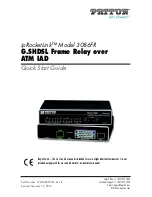
Prestige 681 SDSL Router
B
Glossary
identifier with local significance only and is not the address of the destination.
DNS
Domain Name System links names to IP addresses. When you access Web sites on the
Internet, you can type the IP address of the site or the DNS name. When you type a domain
name in a Web browser, a query is sent to the primary DNS server defined in your Web
browser’s configuration dialog box. The DNS server converts the name you specified to an IP
address and returns this address to your system. From then on, the IP address is used in all
subsequent communications.
Domain
Name
The unique name that identifies an Internet site. Domain Names always have 2 or more parts,
separated by dots. The part on the left is the most specific, and the part on the right is the
most general.
DRAM
Dynamic RAM that stores information in capacitors that must be refreshed periodically.
DSL
Digital Subscriber Line technologies enhances the data capacity of the existing twisted-pair
wire that runs between the local telephone company switching offices and most homes and
offices. There are actually seven types of DSL service, ranging in speeds from 16 Kbits/sec to
52 Mbits/sec. The services are either symmetrical (traffic flows at the same speed in both
directions), or asymmetrical (the downstream capacity is higher than the upstream capacity).
DSL connections are point-to-point dedicated circuits, meaning that they are always
connected. There is no dial-up. There is also no switching, which means that the line is a
direct connection into the carrier’s frame relay, ATM (Asynchronous Transfer Mode), or
Internet-connect system.
DSLAM
A Digital Subscriber Line Access Multiplexer (DSLAM) is a network device, usually at a
telephone company central office, that receives signals from multiple customer Digital
Subscriber Line connections and puts the signals on a high-speed backbone line using
multiplexing techniques. Depending on the product, DSLAM multiplexers connect DSL lines
with some combination of asynchronous transfer mode ATM, frame relay, or IP networks.
DTE
Originally, the DTE (data terminal equipment) was a dumb terminal or printer, but today it is a
computer, or a bridge or router that interconnects local area networks.
HDLC
HDLC (High-level Data Link Control) is a bit-oriented (the data is monitored bit by bit
)
, link
layer protocol for the transmission of data over synchronous networks.
EMI
ElectroMagnetic Interference. The interference by electromagnetic signals that can cause
reduced data integrity and increased error rates on transmission channels.
Ethernet
A very common method of networking computers in a LAN. There are a number of
adaptations to the IEEE 802.3 Ethernet standard, including adaptations with data rates of 10
Mbits/sec and 100 Mbits/sec over coaxial cable, twisted-pair cable, and fiber-optic cable. The
latest version of Ethernet, Gigabit Ethernet, has a data rate of 1 Gbit/sec.
FAQ
(Frequently Asked Questions) -- FAQs are documents that list and answer the most common
questions on a particular subject.
FCC
The FCC (Federal Communications Commission) is in charge of allocating the
electromagnetic spectrum and thus the bandwidth of various communication systems.
Flash
memory
The nonvolatile storage that can be electrically erased and reprogrammed so that data can be
stored, booted, and rewritten as necessary.









































